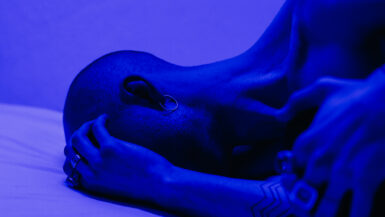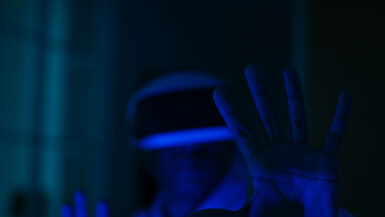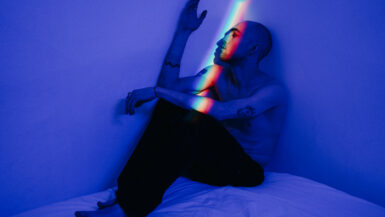In today’s fast-paced, technology-driven world, the impact of blue light on our sleep and productivity is becoming increasingly significant. A plethora of studies have discovered a strong correlation between exposure to blue light and disrupted sleep patterns, which can lead to an array of health issues and reduced work efficiency. This article delves into the lesser-known yet equally crucial aspect of blue light’s influence on sleepwalking and night terrors. By closely examining the latest research findings and expert insights, we aim to shed light on how blue light exposure affects the quality of our sleep, the potential consequences on mental and physical health, and the steps that can be taken to mitigate these effects. Join us as we explore this intriguing topic and unravel the complex relationship between blue light, sleepwalking, and night terrors.
Reducing Blue Light Exposure for Better Sleep
In the quest to improve sleep quality and minimize the occurrence of sleepwalking and night terrors, it is essential to understand the role of blue light in our daily lives. By adopting simple lifestyle changes and introducing innovative technological solutions, we can effectively reduce our exposure to blue light and promote better sleep. In this subsection, we will delve into practical strategies and tips to mitigate blue light exposure, thereby contributing to a restful slumber and reduced sleep disturbances.
Embrace a Blue Light Detox
One of the most effective ways to combat the effects of blue light on sleep is to establish a blue light detox routine. This involves disconnecting from electronic devices such as smartphones, tablets, and computers at least two hours before bedtime. By doing so, you can allow your body to naturally produce the sleep hormone melatonin, which aids in regulating your sleep-wake cycle. Alternatively, you can also consider using blue light blocking glasses, which filter out the harmful blue light emitted from screens, protecting your eyes and promoting better sleep.
Adjust Your Digital Devices
Many digital devices now come with built-in settings that allow users to adjust the color temperature and brightness of their screens. By enabling the night mode or warm color settings on your devices, you can decrease the amount of blue light exposure, especially during evening hours. This simple yet effective step can help reduce the likelihood of sleepwalking and night terrors caused by blue light exposure.
Create a Sleep-Friendly Environment
Establishing a serene and calming environment in your bedroom can significantly impact your sleep quality. Consider replacing traditional LED bulbs with warm, amber-colored lighting, which emits less blue light. Moreover, investing in blackout curtains or shades can also help to block out any external sources of blue light, such as streetlights, which may disrupt your sleep.
Explore Natural Light Therapy
Exposure to natural sunlight during the day can help regulate your body’s internal clock, making it easier to maintain a consistent sleep schedule. By spending time outdoors in the morning or opening your curtains to let sunlight in, you can synchronize your circadian rhythm and reduce the chances of sleep disturbances such as sleepwalking and night terrors.
The Future of Blue Light Research and Sleep Optimization
As our understanding of the impact of blue light on sleep continues to evolve, further research and technological advancements are expected to emerge in the field of sleep optimization. By staying informed about the latest findings, you can proactively implement strategies to mitigate blue light exposure and improve your overall sleep health. To learn more about the cutting-edge developments in this area, be sure to explore our article on The Future of Blue Light Research and Sleep Optimization.
By incorporating these approaches into your daily routine, you can effectively minimize the adverse effects of blue light on your sleep quality and reduce the occurrence of sleepwalking and night terrors. With better sleep comes improved mental and physical well-being, ultimately leading to a healthier and more productive lifestyle.
The Connection between Sleep and Productivity
A good night’s sleep is not just a luxury but a vital aspect of maintaining optimal physical and mental health. The relationship between sleep and productivity is undeniable, as the quality and duration of our sleep directly impacts our cognitive abilities and overall performance during the day. In this section, we will delve into the intricate connection between sleep and productivity, focusing on how blue light exposure can disrupt this delicate balance, and the steps we can take to enhance our sleep quality, ultimately leading to better productivity.
Understanding the Science of Sleep and Cognition
Sleep plays a crucial role in our ability to think clearly, retain information, and make effective decisions. During the different stages of sleep, our brains undergo a series of complex processes, such as the consolidation of memory, elimination of toxins, and the strengthening of neural connections. Disruptions to these processes, such as those caused by blue light exposure, can lead to impaired cognitive function, negatively impacting our productivity during the day.
Blue Light: The Invisible Thief of Quality Sleep
Exposure to blue light, especially during the evening hours, has been shown to suppress melatonin production and disrupt our body’s natural circadian rhythm. This can lead to difficulty falling asleep, frequent awakenings, and reduced sleep quality, all of which contribute to a decline in daytime productivity. Furthermore, prolonged exposure to blue light can exacerbate sleep disorders such as sleepwalking and night terrors, which can have a detrimental effect on our overall sleep health.
Boosting Productivity through Sleep Hygiene
By improving our sleep hygiene and reducing blue light exposure, we can enhance the quality of our sleep and, in turn, boost our productivity. Simple changes, such as establishing a consistent sleep schedule, creating a relaxing bedtime routine, and optimizing our sleep environment, can have a significant impact on our ability to achieve restorative sleep. Additionally, adopting strategies to minimize blue light exposure, as discussed earlier in the article, can further contribute to better sleep and improved daytime performance.
The Far-Reaching Benefits of a Well-Rested Mind
Achieving quality sleep is not just about feeling refreshed and alert during the day; it has a lasting impact on our overall well-being. A well-rested mind is more equipped to handle stress, maintain emotional balance, and foster creativity, all of which contribute to enhanced productivity in both professional and personal spheres. By prioritizing sleep and minimizing blue light exposure, we can unlock our full potential and lead a more fulfilling and successful life.
Through a deeper understanding of the connection between sleep and productivity, we can appreciate the importance of addressing blue light exposure and its impact on sleepwalking and night terrors. By taking proactive steps towards better sleep hygiene and blue light management, we can improve not only our sleep quality but also our cognitive performance and overall well-being.
How Blue Light Affects Sleep Quality
As we explore the role of blue light in sleepwalking and night terrors, it is essential to first understand the underlying mechanisms of how blue light affects sleep quality. This understanding will enable us to appreciate the connection between increased blue light exposure and sleep disturbances such as sleepwalking and night terrors. In this section, we will delve into the science behind blue light’s impact on sleep quality and the biological processes involved in sleep regulation.
The Science of Blue Light and Circadian Rhythm
Blue light, which is emitted by the sun and artificial light sources such as electronic devices, has a wavelength of approximately 480 nanometers. This type of light plays a crucial role in regulating our body’s internal clock, known as the circadian rhythm. During daytime hours, exposure to blue light helps to maintain alertness and cognitive performance. However, excessive exposure to blue light in the evening can disrupt our natural sleep-wake cycle, leading to difficulties in falling asleep and achieving restorative sleep.
Blue Light and Melatonin Suppression
One of the primary ways blue light affects sleep quality is by suppressing the production of melatonin, a hormone responsible for inducing sleepiness. When blue light enters the eyes, it signals the brain to reduce melatonin secretion, leading to increased alertness and wakefulness. This is beneficial during the day but can be detrimental to sleep quality if exposure continues into the evening hours. As a result, excessive blue light exposure can lead to delayed sleep onset, fragmented sleep, and reduced overall sleep duration.
The Domino Effect of Sleep Disruption
When the natural sleep-wake cycle is disrupted due to blue light exposure, the effects can cascade into various aspects of our health and well-being. Poor sleep quality has been linked to a range of physical and mental health issues, including weakened immune function, increased stress levels, mood disorders, and cognitive decline. Furthermore, disrupted sleep can exacerbate existing sleep disorders such as sleepwalking and night terrors, leading to a vicious cycle of sleep disturbances and compromised health.
Blue Light’s Impact on Sleepwalking and Night Terrors
Sleepwalking and night terrors are parasomnias, or abnormal sleep behaviors, that typically occur during the non-rapid eye movement (NREM) stage of sleep. While the exact causes of these sleep disturbances are not fully understood, researchers believe that poor sleep quality and disrupted sleep architecture may play a significant role. As blue light exposure contributes to sleep disruption, it is plausible that excessive exposure may exacerbate sleepwalking and night terrors in susceptible individuals.
Armed with the knowledge of how blue light affects sleep quality, we can better comprehend its potential role in sleepwalking and night terrors. By addressing blue light exposure and promoting healthy sleep habits, we may be able to mitigate the occurrence of these sleep disturbances and improve overall sleep health. Ultimately, managing blue light exposure is an essential component of a comprehensive approach to ensuring a restful and rejuvenating slumber.
Understanding Blue Light and Its Sources
In order to comprehend the connection between blue light exposure and sleep disturbances such as sleepwalking and night terrors, it is crucial to first establish a clear understanding of what blue light is and where it comes from. By identifying the various sources of blue light in our daily lives, we can take the necessary steps to manage our exposure and minimize its impact on our sleep quality. In this subsection, we will explore the nature of blue light, its various sources, and how these sources can affect our sleep health.
What is Blue Light?
Blue light is a component of the visible light spectrum, with a wavelength ranging between 400 and 495 nanometers. It is characterized by its short wavelength and high energy, which makes it more likely to affect our sleep-wake cycle, or circadian rhythm. While blue light is essential for maintaining alertness and cognitive function during the day, excessive exposure during evening hours can have detrimental effects on sleep quality and may contribute to sleep disturbances such as sleepwalking and night terrors.
Natural Sources of Blue Light
The primary natural source of blue light is the sun, which emits a full spectrum of visible light, including blue light. During daytime hours, exposure to natural sunlight can help regulate our circadian rhythm and maintain a healthy sleep-wake cycle. However, as the sun sets and natural light diminishes, our bodies should ideally transition to a state of relaxation and prepare for sleep. It is during this transitional period that excessive exposure to blue light can have the most significant impact on our sleep health.
Artificial Sources of Blue Light
In addition to sunlight, there are numerous artificial sources of blue light that we encounter in our daily lives. These include electronic devices such as smartphones, tablets, computers, and televisions, as well as energy-efficient LED and fluorescent lighting. Due to the widespread use of these devices and lighting solutions, our exposure to blue light has significantly increased, particularly during evening hours when the effects on sleep are most pronounced.
Managing Blue Light Exposure for Optimal Sleep Health
Given the potential impact of blue light on sleep quality and sleep disturbances such as sleepwalking and night terrors, it is essential to take steps to manage our exposure to blue light. This can be achieved through a combination of lifestyle changes and technological solutions, such as establishing a blue light detox routine, adjusting device settings, creating a sleep-friendly environment, and embracing natural light therapy. By adopting these strategies, we can effectively reduce our exposure to blue light and promote better sleep health.
Recognizing the various sources of blue light in our lives is the first step towards addressing its impact on sleepwalking and night terrors. By understanding the nature of blue light and the ways in which it can affect our sleep health, we can make informed decisions about how to manage our exposure and optimize our sleep quality. Ultimately, a comprehensive approach to blue light management is key to ensuring a restful and rejuvenating slumber, free from sleep disturbances.
Blue Light Exposure and Sleep Disorders
The link between blue light exposure and sleep disorders, such as sleepwalking and night terrors, has been a subject of growing interest among researchers and sleep experts. As our understanding of the effects of blue light on sleep quality and circadian rhythm continues to expand, it is essential to explore the potential implications of this exposure on specific sleep disorders. In this subsection, we will delve into the relationship between blue light exposure and sleep disorders, focusing on the role it may play in sleepwalking and night terrors, and the possible steps to mitigate these effects.
Disruption of Sleep Architecture and Sleep Disorders
At the core of the connection between blue light exposure and sleep disorders is the disruption of sleep architecture. Sleep architecture refers to the structure and organization of the various stages of sleep, including rapid eye movement (REM) and non-rapid eye movement (NREM) sleep. Exposure to blue light, particularly during the evening hours, can disrupt the natural progression of these sleep stages and interfere with the restorative processes that occur during sleep. This disruption can, in turn, exacerbate existing sleep disorders, such as sleepwalking and night terrors, which typically occur during NREM sleep.
Blue Light and Sleepwalking
Sleepwalking, also known as somnambulism, is a sleep disorder characterized by episodes of walking or performing complex tasks while still asleep. Although the precise causes of sleepwalking are not yet fully understood, factors such as sleep deprivation, fragmented sleep, and disrupted sleep architecture are believed to play a role. Considering the impact of blue light exposure on sleep quality and the sleep-wake cycle, it is plausible that excessive exposure to blue light may heighten the risk of sleepwalking episodes in susceptible individuals.
Night Terrors and the Influence of Blue Light
Night terrors, or sleep terrors, are episodes of intense fear and panic that occur during NREM sleep, often accompanied by screaming, thrashing, and other distressing behaviors. Like sleepwalking, the exact causes of night terrors are not entirely clear, but they have been linked to sleep disruptions and poor sleep quality. Given the detrimental effects of blue light exposure on sleep architecture, it is reasonable to hypothesize that excessive blue light exposure may contribute to an increased incidence of night terrors in certain individuals.
Strategies for Reducing the Impact of Blue Light on Sleep Disorders
To minimize the potential effects of blue light exposure on sleep disorders such as sleepwalking and night terrors, it is crucial to implement strategies that reduce exposure and promote healthy sleep habits. These may include establishing a consistent sleep schedule, creating a relaxing bedtime routine, optimizing sleep environment, and practicing proper sleep hygiene. In addition, the use of blue light filtering glasses or software that adjusts screen color temperature can help reduce blue light exposure, particularly during the evening hours.
By exploring the relationship between blue light exposure and sleep disorders, we can gain valuable insights into the potential role of blue light in sleepwalking and night terrors. By taking proactive steps to reduce blue light exposure and prioritize sleep health, we can not only improve our overall sleep quality but also mitigate the risks associated with these sleep disorders. Ultimately, a comprehensive approach to managing blue light exposure is critical to achieving a restful and restorative night’s sleep.





Leave a reply